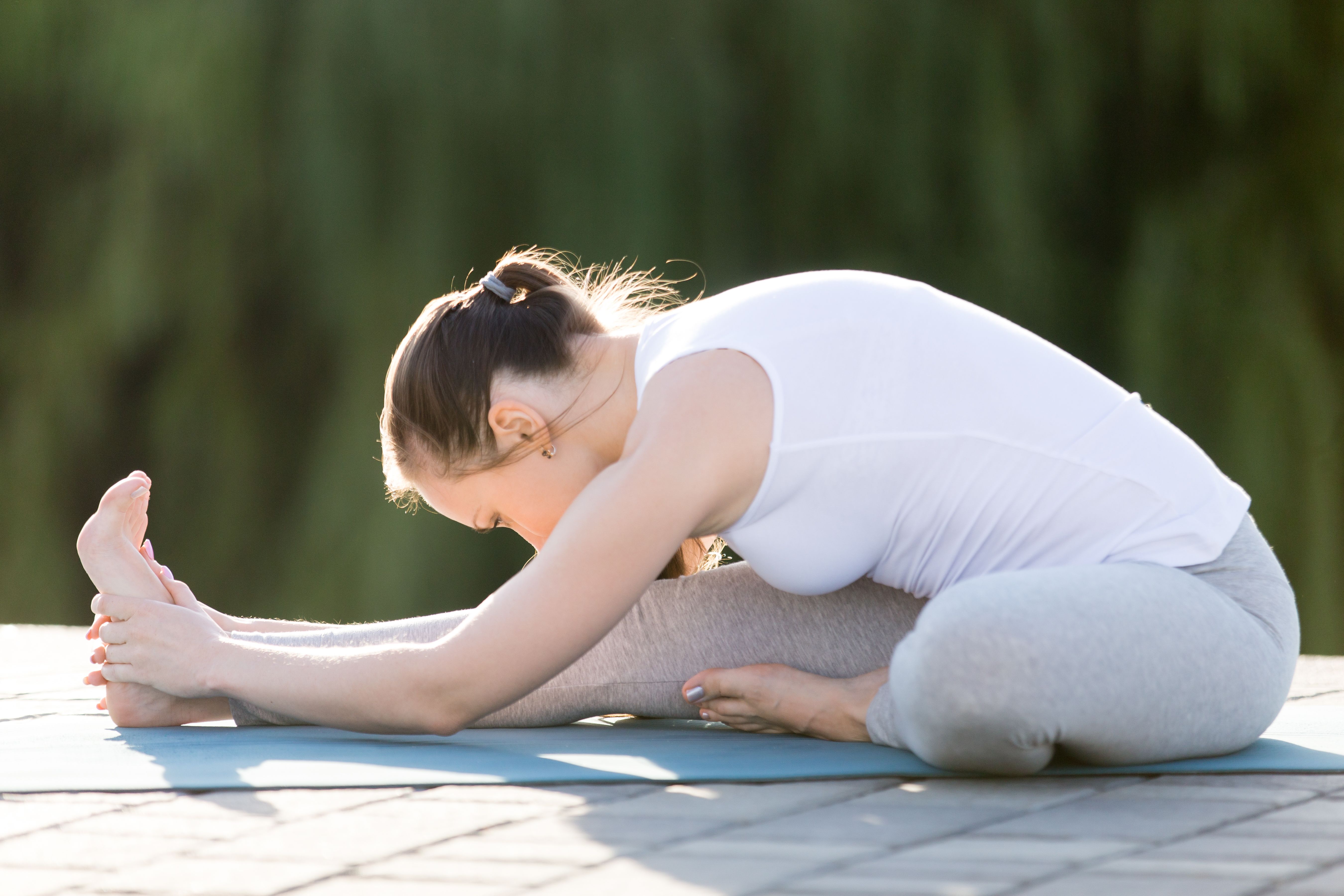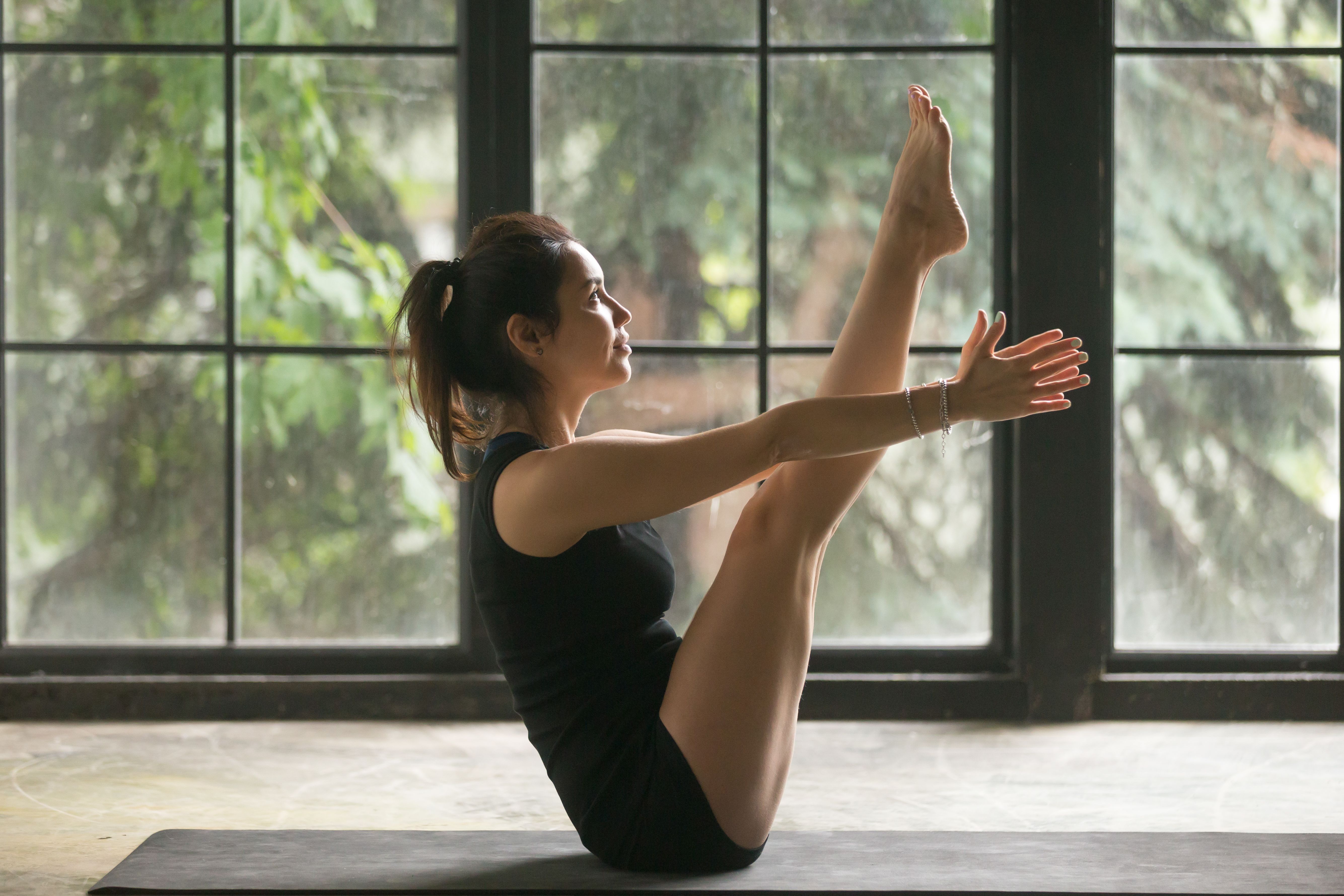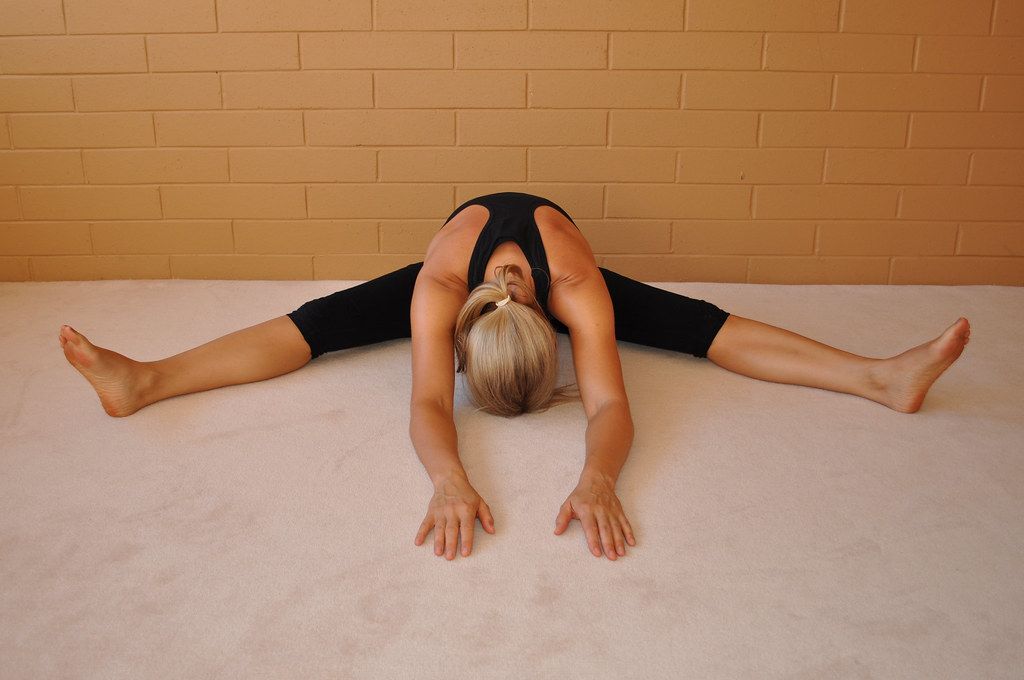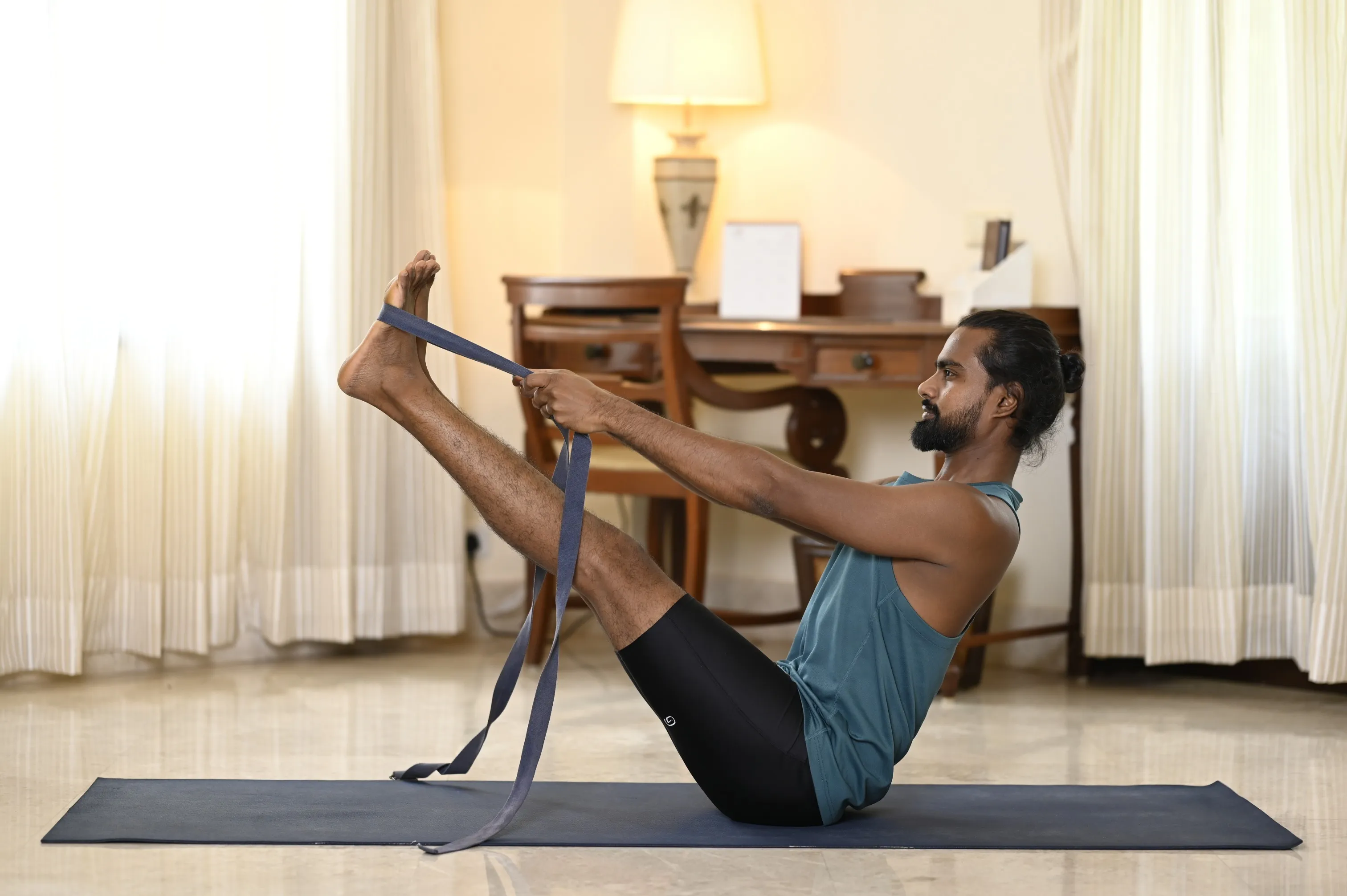What is Kraunchasana (Heron Pose)?

Krounchasana, or Heron Pose, is a seated yoga asana that is part of the modern yoga exercise family, and it helps to stretch the glutes, hamstrings, and calves all at once.
You need a higher level of leg flexibility to get into the Heron pose, so it’s considered an intermediate-to-advanced level yoga pose.
In the Heron pose, one leg is placed on the ground in the Hero pose, and the other leg is flexed upward close to your face. The leg that is flexed straight upward is held with both hands, so Krounchasana also helps activate your shoulders as well.
Krounchasana has similar benefits to the Seated Forward Bending pose – Paschimottanasana – but the intensity and flexion in the legs is much higher in the Heron pose.
Overview & Etymology
Kraunchasana is a combination of Sanskrit words Kraunch, which means Heron (a large water bird with long legs), and Asana, which means posture or pose.
In ancient yoga texts like the 19th century Sritattvanidhi, Kraunchasana was mentioned as a different pose. Back then, it was a squatting position rather than a seated yoga asana.
In modern yoga texts like Light on Yoga by B. K. S. Iyengar and First Steps to Higher Yoga by Swami Yogesvarananda, Kraunchasana is used as a preparatory pose for the Bakasana (Crane Pose) practice.
Sanskrit Name: क्रौञ्चासन Pronunciation: crown-CHAHS-ah-nuh
Pose Type: Seated Stretch Also known as: Heron Pose
Strengthens: Core, Shoulders, and Hamstrings Stretches: Spine, Legs, and Hamstrings
Health Benefits of Kraunchasana
Lengthens the spine and legs.
Tones the transverse abdominis.
Enhances digestive system health.
Strengthens the core and hamstrings.
Increases the lower body’s range of motion.
Stretches the hamstrings, back, and glutes.
Calms the nervous system and relieves stress.
Has therapeutic effects for chronic back pain and flat feet.
When to Avoid Performing Kraunchasana
Avoid if you have a hernia.
Avoid if you have spondylitis.
Avoid if you have a slipped disc.
Avoid if you’ve had a recent injury.
Avoid if you’ve had a recent surgery.
Avoid this pose during menstruation and pregnancy.
Avoid if you have inflammatory knee or spine arthritis.
How to do Kraunchasana (Heron Pose)
We’ve divided this detailed guide for Kraunchasana into four different parts below.
Part 1 - Preparatory Poses for Kraunchasana
If you are a beginner, start your Heron pose practice with the following warm-up yoga asanas.
These will help you activate your legs, ankles, core, and spine for the primary practice:
1. Baddha Konasana (Bound Angle Forward) - As the Heron Pose is a seated yoga asana, you should start with opening your pelvis and legs. Begin by sitting in a Staff pose and create a butterfly formation with your legs. Ensure that your knees are close to the mat.

Keep your spine tall, hold your feet together with your palms, stay in this stance, and breathe deeply for a few minutes. You can also quickly increase blood circulation in your pelvic area by flapping your legs like butterfly wings.
2. Virasana (Hero Pose) - Sit in a kneeling position on the mat and keep your spine straight. Hold this pose for 1 to 3 minutes.

This pose will increase blood flow in the entire lower body by activating your knees, ankles, thighs, and shins all at once.
3. Janu Sirsasana (Head-to-Knee Pose) - This is a popular posture from the Seated Forward Bend category in Ashtanga Yoga. Start by sitting in Staff pose, then bend one leg in a half-butterfly stance while keeping the other leg straight in front of you. Now, gently bend your torso toward your straight leg on the ground.

This pose is quite similar to Kraunchasana, except that it is done on the ground. The support from the ground will open your hamstrings and back muscles and help newbies develop a stronger foundation for the Heron pose.
4. Navasana (Boat Pose) - To hold the Kraunchasana for a longer duration, you will need an active core. So, get into Dandasana and gently shift your body weight from your pelvis to your tailbone.

Now, inhale and tighten your abdominal muscles as you lift a single leg off the mat at a time. Extend your arms straight and point your legs up diagonally. Hold this pose here for 1-3 minutes, and then relax. You can also practice Boat pose with props and variations for easy execution.
Part 2: Step-by-Step Instructions to Perform Kraunchasana
The following are steps to practice the Heron Pose:
Step 1- Inhale as you start by sitting in Dandasana (Staff Pose).
Step 2- Next, bend your left leg in Ardha Virasana (Half-Hero Pose) and keep your right leg straight on the ground.
Step 3- Engage your core, straighten your spine and ensure that you remain balanced so that you don’t fall while executing the main Heron pose.
Step 4- Now, bend your right leg and hold your foot with both hands.
Step 5- Slowly, start to lift your right leg off the mat and bring it close to your face by keeping your back upright, shoulders dropping back, and keeping your chest open in the front.
Step 6- If possible, touch the shin of your leg with your forehead and hold this pose here for a few seconds.
Step 7- Gently bring your right leg back to the ground and get into the Staff pose again.
Step 8- Relax both legs in Staff pose for a few seconds, then repeat the same on the other side.
Breath Awareness:
Inhale - When you sit in Staff pose, engage your core muscles and lift the leg up.
Exhale - When your leg is parallel to your forehead and when you release te Heron pose.
Performance Duration for Beginners: Hold Kraunchasana for 30 seconds on each side.
Performance Duration for Advanced: Hold Kraunchasana for 1-2 minutes on each side.
Part 3: Things to Keep in Mind
Is this your first time performing Kraunchasana? Here are a few crucial posture cues in mind:
Try not to overstretch: Kraunchasana is an intermediate to advanced stretch for the hamstrings. Overstretching of the hamstrings can occur while pulling your leg close to your forehead. If you feel the stretch is getting slightly painful or uncomfortable, kindly stop and try to modify your practice with props. Overstretching can cause severe muscle tears around the hamstrings and abductors.
Keep the core engaged: If you’re unable to sit and balance in Kraunchasana, it means you need to engage your core muscles by stabilizing your abs, obliques, lower back, spine, and thighs all at once. This will help you build a stronger foundation for the balancing act of Heron pose. The more engaged you keep your core muscles while holding the posture, the more toned you will get.
Part 4: Relaxing Poses After Kraunchasana
Post Heron pose practice, your entire body might feel intense pressure around your core and hamstrings. Here are a few poses to relax and rejuvenate the body:
1. Paschimottanasana (Seated Forward Bend): After Kraunchasana, get into Dandasana and focus on your breathing for a few seconds. Now, inhale deeply as you raise both arms over your head and start bending forward onto your legs.

Rest your forehead on your knees and extend your arms in front as you relax your spine, hamstrings, glutes, and shoulders. This pose is best done with a slight bend in the knees.
2. Upavistha Konasana (Wide-Angle Seated Forward Bend): For complete relaxation of your lower back and inner thighs, get into the wide-angle seated stance and start bending your upper body forward until you reach the ground.

This pose is very similar to Paschimottanasana and targets the same muscles. The significant difference between both is that you will feel increased relaxation in the sacrum and inner thighs.
Kraunchasana Variations to Consider
Based on your physical flexibility and mobility, you can try multiple variations of Kraunchasana. Here are a few listed below:
1. Heron Pose with Bent Leg: If you’re just starting your Heron pose practice, it’s wise to choose a bent leg lift stance because of the intensive flexion in the legs.

To get into this variation, simply continue the same steps for Kraunchasana, but make sure the knee is bent at a 90-degree angle. This will reduce the intensity of the stretch and help you gradually build strength for the main posture.
2. Revolved Heron Pose Variation: Those who want to improve their leg and hip flexor strength can try this beginner to intermediate-level posture variation.

If you’re only focused on working with one leg at a time, it’s easier to maintain your balance while also strengthening your hip flexors and obliques at the same time.

Enjoy a Free 1-on-1 Session with a Coach!
Receive personalized guidance tailored to your unique fitness goals, live with a dedicated coach—no credit card required.
Frequently Asked Questions about Kraunchasana
The following are some important health benefits of Kraunchasana:
- Relieves chronic back pain.
- Strengthens the core and legs.
- Improves digestion and abdominal organ function.
- Stretches the spine, neck, shoulders, and hamstrings.
- Activates the Manipura Chakra and increases the flow of Prana (Energy) in the body.
Follow the steps below to perform Kraunchasana:
Inhale and sit straight in the Staff Pose.
Fold one leg into Hero pose and keep the other leg extended forward.
Take a few deep breaths, engage your core, bend your extended leg and lift it upwards.
Hold your foot with your arms, straighten your leg and pull it closer to your face. Make sure that your back is straight and your chest is open.
Hold this pose for a few deep breaths, release, relax into Staff pose again, and repeat the same on the other side.
Beginners should avoid performing a full leg stretch in the Kraunchasana pose, because when overstretched, it can harm the hamstrings.
As a beginner, you can start with easy variations and modifications for the Heron pose. This will not only help you become more flexible and strong, but it will also keep you safe from unnecessary strain and muscle tears in your legs.
The two most common types of variation poses in Kraunchasana are,
Heron Pose with Bent Leg: This is a beginner-friendly variation. Here, you perform the Kraunchasana normally but keep your lifted leg bent. This variation helps beginners build a range of motion, mind-muscle connection, and some core stability in the initial stage of their practice.
Revolved Heron Pose: As the name suggests, the process of lifting any one leg upward and close to your head is similar, but now you also need to twist your spine and gaze from behind to the other side to give you a deeper burn in your obliques.



%20(7).jpg)





